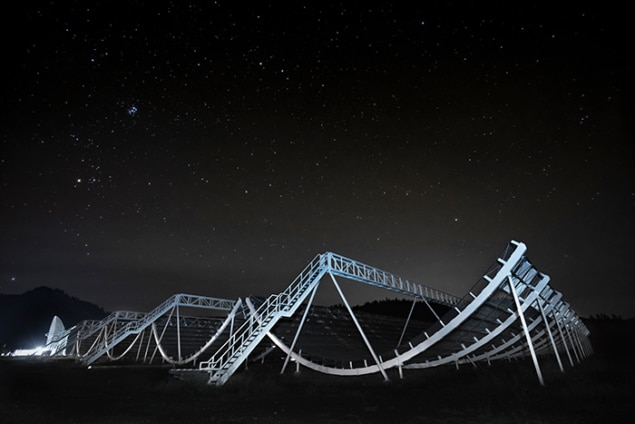
Canada has finished the construction of the country’s largest radio telescope. The C$16m Canadian Hydrogen Intensity-Mapping Experiment (CHIME) near Penticton, British Columbia, is the first research telescope to be built in Canada in more than 30 years. A ceremony to mark the completion of the telescope was attended yesterday by Canadian science minister Kirsty Duncan.
CHIME is located at the National Research Council of Canada’s Dominion Radio Astrophysical Observatory, which is about 260 km east of Vancouver. The observatory boasts four 100 m-long u-shaped cylinders of metal mesh and collects radio waves with wavelengths between 37–75 cm – similar to the wavelength used by mobile phones. Signals collected by the CHIME telescope will be digitally sampled nearly one billion times per second, then processed to produce an image of the sky.
Bizarre bursts
Astronomers will use the telescope to map a quarter of the observable universe to help better understand the nature of dark energy as well as study fast radio bursts. “CHIME’s unique design will enable us to tackle one of the most puzzling new areas of astrophysics today – Fast Radio Bursts,” says Victoria Kaspi from McGill University, who is a member of the CHIME collaboration. “The origin of these bizarre extragalactic events is presently a mystery, with only two dozen reported since their discovery a decade ago. CHIME is likely to detect many of these objects every day, providing a massive treasure trove of data that will put Canada at the forefront of this research.”
CHIME is a collaboration of 50 Canadian scientists from NRC and the Universities of British Columbia, Toronto and McGill. “CHIME is an extraordinary example showcasing Canada’s leadership in space science and engineering,” notes Duncan. “The new telescope will be a destination for astronomers from around the world who will work with their Canadian counterparts to answer some of the most profound questions about space.”



